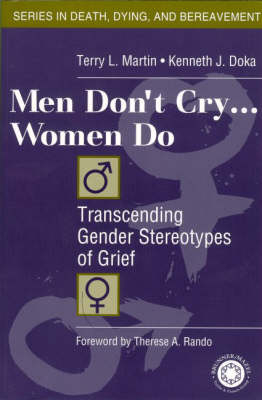
Men Don't Cry, Women Do
Transcending Gender Stereotypes of Grief
Seiten
1999
Brunner-Mazel Inc (Verlag)
978-0-87630-995-7 (ISBN)
Brunner-Mazel Inc (Verlag)
978-0-87630-995-7 (ISBN)
- Titel erscheint in neuer Auflage
- Artikel merken
Zu diesem Artikel existiert eine Nachauflage
This new text, while emphasizing that there are many ways to cope with grief, offers a refreshing change from the popular gender sterotypes of grief. It identifies and explores the various patterns of grieving.
Do men and women grieve differently? This text, while emphasizing that there are many ways to cope with grief, offers a refreshing change from the popular gender stereotypes of grief. Two patterns of grieving are described: an intuitive pattern where individuals experience and express grief in an affective way (stereotyped as female); and an instrumental pattern where grief is expressed physically or cognitively (stereotyped as male). A third pattern representing a blending of these two is also introduced. Of critical importance is that such patterns are related to, but not determined by, gender; and each has distinct strengths and weaknesses.
Organized into three main parts, this topical new text begins by defining terms, introducing and delineating the grief patterns, and rooting the book's concept in contemporary theories of grief. The second part speculates on factors that may influence individuals' patterns of coping with loss (e.g., personality, gender, culture, etc.). The final part considers implications and therapeutic interventions likely to be effective with different types of grievers.
Do men and women grieve differently? This text, while emphasizing that there are many ways to cope with grief, offers a refreshing change from the popular gender stereotypes of grief. Two patterns of grieving are described: an intuitive pattern where individuals experience and express grief in an affective way (stereotyped as female); and an instrumental pattern where grief is expressed physically or cognitively (stereotyped as male). A third pattern representing a blending of these two is also introduced. Of critical importance is that such patterns are related to, but not determined by, gender; and each has distinct strengths and weaknesses.
Organized into three main parts, this topical new text begins by defining terms, introducing and delineating the grief patterns, and rooting the book's concept in contemporary theories of grief. The second part speculates on factors that may influence individuals' patterns of coping with loss (e.g., personality, gender, culture, etc.). The final part considers implications and therapeutic interventions likely to be effective with different types of grievers.
Introduction. Understanding the Grieving Process. Patterns of Grieving. Dissonant Patterns of Grief. Pathways to Patterns. Gender and Grief. Personality and Patterns of Grief. Culture as a Shaping Agent. Strategies for Intervention. Conclusion.
| Erscheint lt. Verlag | 20.1.2000 |
|---|---|
| Reihe/Serie | Series in Death, Dying, and Bereavement |
| Verlagsort | New York |
| Sprache | englisch |
| Maße | 152 x 229 mm |
| Gewicht | 282 g |
| Themenwelt | Geisteswissenschaften ► Psychologie ► Biopsychologie / Neurowissenschaften |
| Geisteswissenschaften ► Psychologie ► Verhaltenstherapie | |
| Sozialwissenschaften ► Soziologie ► Gender Studies | |
| Sozialwissenschaften ► Soziologie ► Mikrosoziologie | |
| ISBN-10 | 0-87630-995-3 / 0876309953 |
| ISBN-13 | 978-0-87630-995-7 / 9780876309957 |
| Zustand | Neuware |
| Informationen gemäß Produktsicherheitsverordnung (GPSR) | |
| Haben Sie eine Frage zum Produkt? |
Mehr entdecken
aus dem Bereich
aus dem Bereich
Grundlagen, Klinik, Rehabilitation
Buch | Softcover (2024)
Urban & Fischer in Elsevier (Verlag)
56,00 €
Buch | Spiralbindung (2022)
modernes lernen (Verlag)
29,95 €
Grundlagen, Klinik, Therapie und Verlauf der …
Buch | Softcover (2024)
Kohlhammer (Verlag)
84,00 €



